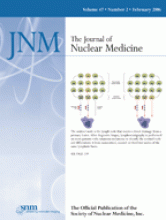REPLY: We read with great interest the letter by Mathelin and Guyonnet entitled “Scintillation Crystal or Semiconductor γ-Probes: An Open Debate.” This debate was the main subject of our referenced paper (1). Our main objective was to compare, for the first time, clinical results using a scintillator probe with those using a semiconductor probe.
In this study, we took the opportunity to measure counting-rate efficiency for each probe tested based on clinical values, such as axillary sentinel lymph node activity. In our experience, the scintillator probe provided a better detection rate than the semiconductor probe. We believe these results were partly due to the better counting efficiency of the scintillator probe, compared with that of the semiconductor probe.
Considering the low activity intake in a sentinel lymph node (50 kBq/0.15% of injected activity), we concluded that counting efficiency may be the dominant performance factor required for sentinel lymph node detection. Britten reached the same conclusion from an in vitro simulation study (2).
Spatial resolution represents the ability to accurately localize 2 hot sources close to each other. We agree with Mathelin and Guyonnet that spatial resolution is related to the open diameter of the probe, which roughly defines the solid angle of detection. Nevertheless, counting efficiency is also highly dependent on source detector geometry (3). The geometric sensitivity is the fraction of emitted radiation that intersects the detector relative to the solid angle.
We apologize for the inadvertent errors in the spatial resolution values quoted in Table 1. For the bismuth germanate probe, 5 mm is the detector diameter, but for probes B and C, the 14-mm measurement is the external diameter of the handheld device. Detector diameter and thickness are not communicated by the manufacturer. Spatial resolution (cm) reported as the full width at half maximum of the sensitivity profile in relation to the 57Co source close to the detector in water was 0.8 for probe C equipped with an external collimator.
Considering that counting efficiency and linear resolution vary inversely, we believe that the probe with the best counting efficiency represents the better compromise for sentinel lymph node detection in the case of breast cancer. Further clinical studies are needed to validate this hypothesis.
An interesting research project would be to test a new prototype scintillator probe, such as yttrium aluminate perovskite and lutetium oxyorthosilicate, especially in a clinical context.







